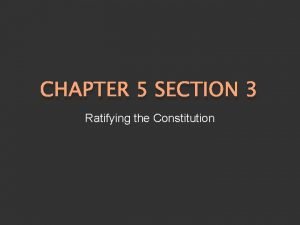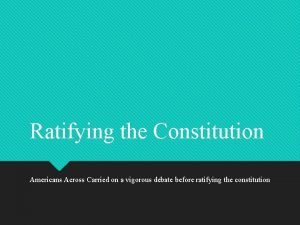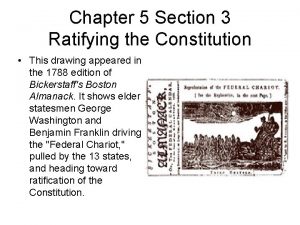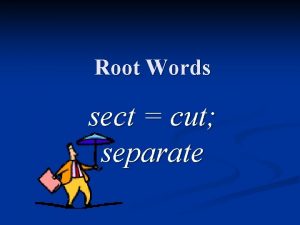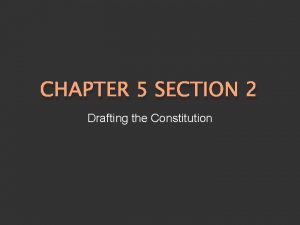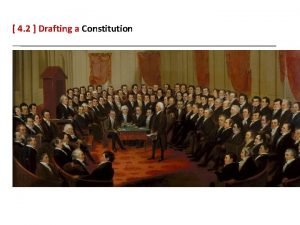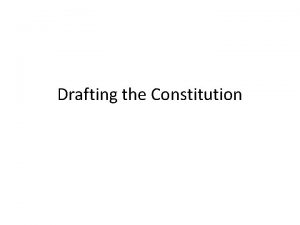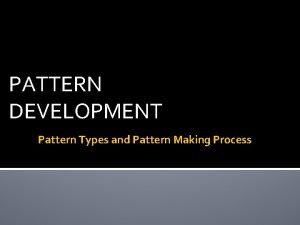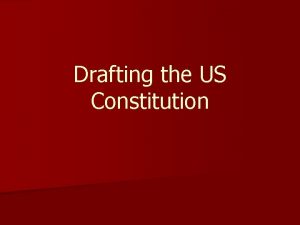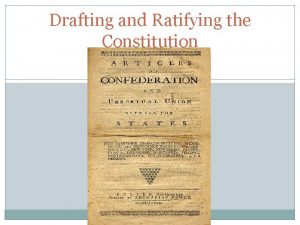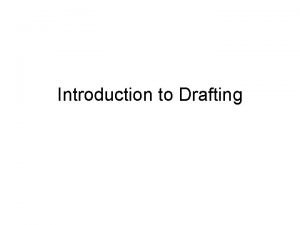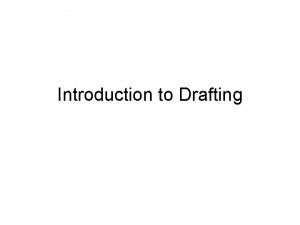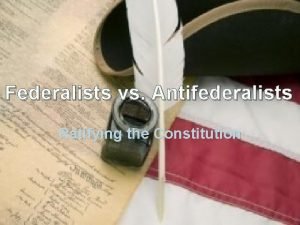Drafting the Constitution Sect 2 Ratifying the Constitution











- Slides: 11

Drafting the Constitution – Sect. 2 Ratifying the Constitution – Sect. . 3 Mitten – CSHS AMAZ History – Semester 1

Nationalists Strengthen Government • Shay’s Rebellion • 1786 -87 armed farmers demand closing of courts to avoid losing farms • Shay’s Rebellion – state militia defeats farmers led by Daniel Shays – Many leaders fear rebellion will spread through country – George Washington calls for stronger national government

Nationalists Strengthen Government • Call for Convention • 5 states send delegates to meeting on interstate trade (1786) – Shay’s Rebellion leads 12 states to join Constitutional Convention – James Madison of Virginia known as “Father of the Constitution” • Convention Highlights – In 1787, 55 delegates meet at Pennsylvania State House – Washington unanimously elected presiding officer

Conflict and Compromise • Big States Versus Small States • Delegates recognize need to strengthen central government – Madison’s Virginia Plan: bicameral legislature based on population – William Paterson’s New Jersey Plan: single house, one vote per state • Roger Sherman, delegate from Connecticut, proposes Great Compromise – Senate has equal representation, elected by state legislatures – House of Representatives, based on population, elected by people

Conflict and Compromise • Slavery Related Issues – South wants slaves in population count for House, not for taxes – North wants slaves in population count for taxes, not for House • Three-Fifths Compromise allows 3/5 of state’s slaves to be counted – Cannot interfere with slave trade for 20 years

Creating a New Government • Division of Powers • Federalism – division of power between national and state governments – National government has delegated or enumerated powers • Nation handles foreign affairs, defense, interstate trade, money – Powers kept by states are called reserved powers • States handle education, marriage laws, trade within state • Shared powers include right to tax, borrow money, establish courts

Creating a New Government • • Separation of Powers Legislative branch makes laws Executive branch carries out laws Judicial branch interprets laws – Checks and balances prevent one branch from dominating the others – Electoral college – electors chosen by states to vote for president • Creating the Constitution – Constitution can be changed through amendment process

Ratifying the Constitution – Sect. 3 • Controversies over the Constitution • Ratification (official approval) requires the support of nine states • Federalists favor balance between state, national governments • Antifederalists oppose strong central government: – may serve interests of privileged minority – unlikely to manage a large country well – Constitution does not protect individual rights

Federalists and Antifederalists • The Opposing Forces • Urban centers Federalist; merchants, workers favor trade regulations – Small or weak states want protection of strong government • Rural areas Antifederalist; farmers fear additional taxes – Large or strong states fear loss of freedom to strong government • The Federalist – essays that defend, explain, analyze Constitution • Antifederalists read Letters from the Federal Farmer: – lists rights they want protected

Bill of Rights • People Demand a Bill of Rights • Antifederalists demand written guarantee of people’s rights • Federalists promise bill of rights if states ratify Constitution • Ratification of the Constitution • December 1787 – June 1788, nine states ratify Constitution • After opposition and debate, Virginia and New York ratify by 1788

Ratification • Adoption of a Bill of Rights • 1791, Bill of Rights, or first ten amendments, ratified by states – First Amendment – freedom of religion, speech, press, politics – Second, Third – right to bear arms, no quartering of soldiers – Fourth through Eighth – fair treatment for persons accused of crimes – Ninth – people’s rights not limited to those mentioned in Constitution – Tenth – people, states have all rights not specifically assigned
 Ratifying the constitution chapter 5 section 3
Ratifying the constitution chapter 5 section 3 Chapter 5 section 3 ratifying the constitution answer key
Chapter 5 section 3 ratifying the constitution answer key Ratifying the constitution chapter 5 section 3
Ratifying the constitution chapter 5 section 3 Sect root word
Sect root word Chapter 5 section 2 drafting the constitution
Chapter 5 section 2 drafting the constitution The new jersey plan
The new jersey plan Drafting the constitution
Drafting the constitution Nc constitution vs us constitution
Nc constitution vs us constitution Constitution what is constitution
Constitution what is constitution The constitution lesson 1 principles of the constitution
The constitution lesson 1 principles of the constitution Texas constitution vs u.s. constitution venn diagram
Texas constitution vs u.s. constitution venn diagram Types of pattern drafting
Types of pattern drafting
